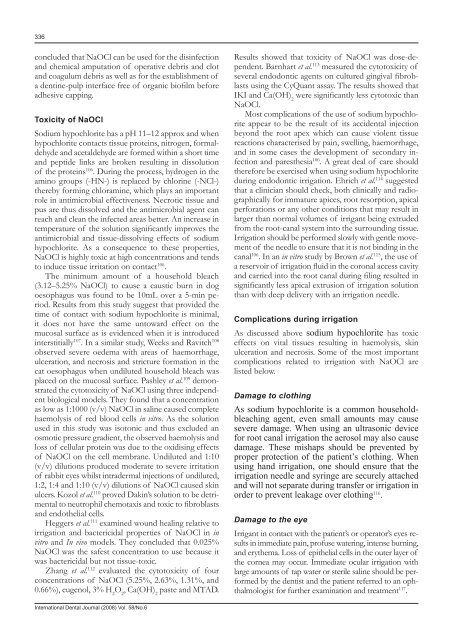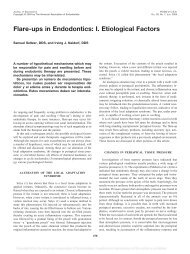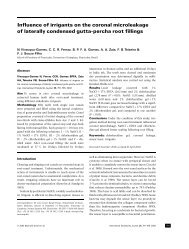Sodium hypochlorite in endodontics
Sodium hypochlorite in endodontics
Sodium hypochlorite in endodontics
Create successful ePaper yourself
Turn your PDF publications into a flip-book with our unique Google optimized e-Paper software.
336<br />
concluded that NaOCl can be used for the dis<strong>in</strong>fection<br />
and chemical amputation of operative debris and clot<br />
and coagulum debris as well as for the establishment of<br />
a dent<strong>in</strong>e-pulp <strong>in</strong>terface free of organic biofilm before<br />
adhesive capp<strong>in</strong>g.<br />
Toxicity of NaOCl<br />
<strong>Sodium</strong> <strong>hypochlorite</strong> has a pH 11–12 approx and when<br />
<strong>hypochlorite</strong> contacts tissue prote<strong>in</strong>s, nitrogen, formaldehyde<br />
and acetaldehyde are formed with<strong>in</strong> a short time<br />
and peptide l<strong>in</strong>ks are broken result<strong>in</strong>g <strong>in</strong> dissolution<br />
of the prote<strong>in</strong>s106 . Dur<strong>in</strong>g the process, hydrogen <strong>in</strong> the<br />
am<strong>in</strong>o groups (-HN_ ) is replaced by chlor<strong>in</strong>e (-NCl_ )<br />
thereby form<strong>in</strong>g chloram<strong>in</strong>e, which plays an important<br />
role <strong>in</strong> antimicrobial effectiveness. Necrotic tissue and<br />
pus are thus dissolved and the antimicrobial agent can<br />
reach and clean the <strong>in</strong>fected areas better. An <strong>in</strong>crease <strong>in</strong><br />
temperature of the solution significantly improves the<br />
antimicrobial and tissue-dissolv<strong>in</strong>g effects of sodium<br />
<strong>hypochlorite</strong>. As a consequence to these properties,<br />
NaOCl is highly toxic at high concentrations and tends<br />
to <strong>in</strong>duce tissue irritation on contact106 .<br />
The m<strong>in</strong>imum amount of a household bleach<br />
(3.12–5.25% NaOCl) to cause a caustic burn <strong>in</strong> dog<br />
oesophagus was found to be 10mL over a 5-m<strong>in</strong> period.<br />
Results from this study suggest that provided the<br />
time of contact with sodium <strong>hypochlorite</strong> is m<strong>in</strong>imal,<br />
it does not have the same untoward effect on the<br />
mucosal surface as is evidenced when it is <strong>in</strong>troduced<br />
<strong>in</strong>terstitially107 . In a similar study, Weeks and Ravitch108 observed severe oedema with areas of haemorrhage,<br />
ulceration, and necrosis and stricture formation <strong>in</strong> the<br />
cat oesophagus when undiluted household bleach was<br />
placed on the mucosal surface. Pashley et al. 109 demonstrated<br />
the cytotoxicity of NaOCl us<strong>in</strong>g three <strong>in</strong>dependent<br />
biological models. They found that a concentration<br />
as low as 1:1000 (v/v) NaOCl <strong>in</strong> sal<strong>in</strong>e caused complete<br />
haemolysis of red blood cells <strong>in</strong> vitro. As the solution<br />
used <strong>in</strong> this study was isotonic and thus excluded an<br />
osmotic pressure gradient, the observed haemolysis and<br />
loss of cellular prote<strong>in</strong> was due to the oxidis<strong>in</strong>g effects<br />
of NaOCl on the cell membrane. Undiluted and 1:10<br />
(v/v) dilutions produced moderate to severe irritation<br />
of rabbit eyes whilst <strong>in</strong>tradermal <strong>in</strong>jections of undiluted,<br />
1:2, 1:4 and 1:10 (v/v) dilutions of NaOCl caused sk<strong>in</strong><br />
ulcers. Kozol et al. 110 proved Dak<strong>in</strong>’s solution to be detrimental<br />
to neutrophil chemotaxis and toxic to fibroblasts<br />
and endothelial cells.<br />
Heggers et al. 111 exam<strong>in</strong>ed wound heal<strong>in</strong>g relative to<br />
irrigation and bactericidal properties of NaOCl <strong>in</strong> <strong>in</strong><br />
vitro and In vivo models. They concluded that 0.025%<br />
NaOCl was the safest concentration to use because it<br />
was bactericidal but not tissue-toxic.<br />
Zhang et al. 112 evaluated the cytotoxicity of four<br />
concentrations of NaOCl (5.25%, 2.63%, 1.31%, and<br />
0.66%), eugenol, 3% H O , Ca(OH) paste and MTAD.<br />
2 2 2<br />
International Dental Journal (2008) Vol. 58/No.6<br />
Results showed that toxicity of NaOCl was dose-dependent.<br />
Barnhart et al. 113 measured the cytotoxicity of<br />
several endodontic agents on cultured g<strong>in</strong>gival fibroblasts<br />
us<strong>in</strong>g the CyQuant assay. The results showed that<br />
IKI and Ca(OH) 2 were significantly less cytotoxic than<br />
NaOCl.<br />
Most complications of the use of sodium <strong>hypochlorite</strong><br />
appear to be the result of its accidental <strong>in</strong>jection<br />
beyond the root apex which can cause violent tissue<br />
reactions characterised by pa<strong>in</strong>, swell<strong>in</strong>g, haemorrhage,<br />
and <strong>in</strong> some cases the development of secondary <strong>in</strong>fection<br />
and paresthesia 106 . A great deal of care should<br />
therefore be exercised when us<strong>in</strong>g sodium <strong>hypochlorite</strong><br />
dur<strong>in</strong>g endodontic irrigation. Ehrich et al. 114 suggested<br />
that a cl<strong>in</strong>ician should check, both cl<strong>in</strong>ically and radiographically<br />
for immature apices, root resorption, apical<br />
perforations or any other conditions that may result <strong>in</strong><br />
larger than normal volumes of irrigant be<strong>in</strong>g extruded<br />
from the root-canal system <strong>in</strong>to the surround<strong>in</strong>g tissue.<br />
Irrigation should be performed slowly with gentle movement<br />
of the needle to ensure that it is not b<strong>in</strong>d<strong>in</strong>g <strong>in</strong> the<br />
canal 106 . In an <strong>in</strong> vitro study by Brown et al. 115 , the use of<br />
a reservoir of irrigation fluid <strong>in</strong> the coronal access cavity<br />
and carried <strong>in</strong>to the root canal dur<strong>in</strong>g fil<strong>in</strong>g resulted <strong>in</strong><br />
significantly less apical extrusion of irrigation solution<br />
than with deep delivery with an irrigation needle.<br />
Complications dur<strong>in</strong>g irrigation<br />
As discussed above sodium <strong>hypochlorite</strong> has toxic<br />
effects on vital tissues result<strong>in</strong>g <strong>in</strong> haemolysis, sk<strong>in</strong><br />
ulceration and necrosis. Some of the most important<br />
complications related to irrigation with NaOCl are<br />
listed below.<br />
Damage to cloth<strong>in</strong>g<br />
As sodium <strong>hypochlorite</strong> is a common householdbleach<strong>in</strong>g<br />
agent, even small amounts may cause<br />
severe damage. When us<strong>in</strong>g an ultrasonic device<br />
for root canal irrigation the aerosol may also cause<br />
damage. These mishaps should be prevented by<br />
proper protection of the patient’s cloth<strong>in</strong>g. When<br />
us<strong>in</strong>g hand irrigation, one should ensure that the<br />
irrigation needle and syr<strong>in</strong>ge are securely attached<br />
and will not separate dur<strong>in</strong>g transfer or irrigation <strong>in</strong><br />
order to prevent leakage over cloth<strong>in</strong>g116 .<br />
Damage to the eye<br />
Irrigant <strong>in</strong> contact with the patient’s or operator’s eyes results<br />
<strong>in</strong> immediate pa<strong>in</strong>, profuse water<strong>in</strong>g, <strong>in</strong>tense burn<strong>in</strong>g,<br />
and erythema. Loss of epithelial cells <strong>in</strong> the outer layer of<br />
the cornea may occur. Immediate ocular irrigation with<br />
large amounts of tap water or sterile sal<strong>in</strong>e should be performed<br />
by the dentist and the patient referred to an ophthalmologist<br />
for further exam<strong>in</strong>ation and treatment 117 .





